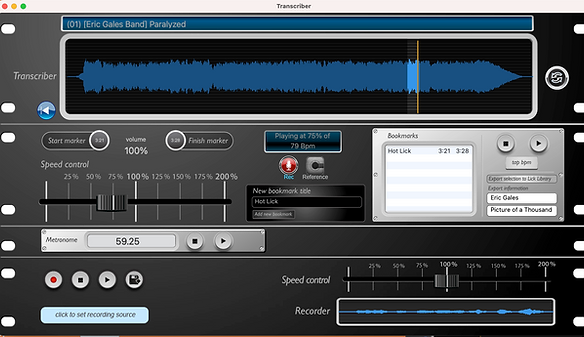



All for the price of 2 Guitar Lessons!
May 19th, 2025. Version 9.1.0 is out for Windows and 9.0.5 for Mac. For updates, this is a full install. Go here to find out more info. In the update app, on mac, download from the browser button. Try it out for 10 free days!
Brand new - the manual - get it free here!
The Best Guitar and Bass Guitar gym ever!
Learn to sight-read now!


Click on the image Below to check out the tools
Check the clock - is it time for dinner?
Clicking the instrument here will select guitar, 4 string, 5 string or 6 string Bass
The Metronome (See Home Page)
The Tuner (See Home Page)
The Practice Scheduler (See Home Page)

This box lists a description of the portal (the circles above) you chose, as well as a list of the tools available for that portal..
Hovering over the name of the tool will change the text to tell you a little bit about it. There is an open button next to each one, so you can check that out.

"Looking forward to digging in to all the great features. I’ve had a quick look around the sight reading part already. Looks really comprehensive and well thought out.
I have to say, I am already really BLOWN AWAY by how much work and thought you must have put into this. Truly amazing and very impressive."
- Bernie – First time user
You can also buy it in the software

Set List Manager
In the beginning the tool was an app I put together quickly so I could play backing tracks and make notes when remembering parts for songs in bands.
I thought, "hey, let's put in Guitar SightReader Toolbox". I have included 2 default setlist files. One with backing tracks and the other is the full list of songs for the New Zealand School of Music Jazz degree.
So from the screenshot above, you know that you can upload images to go with your tunes. There is a jukebox that can play the songs that are ticked one after another. When the next song starts, its chord chart also changes.
Here's an interesting thought. You can send a song to the transcriber. Go through it and export hot licks to a lick Library!

Transcriber
In the transcriber, you can open a song file and change its speed without changing the pitch.
You can select snippets to loop or play by clicking on the wave. Left-click will set the start point, and right-click will set the end point.
The other way to set the endpoint is to press the V key while it's playing.
Below the transcriber is a metronome that syncs to the tempo of the song - including when you slow it down or speed it up.
Below that is the audio recorder. Here you can record yourself to see if you are really nailing the lick you're hearing. Under the tempo window, there is a control that will flip the bottom panel from recording to a guitar and piano view. The piano tab is black - click to the right of the guitar tab, and a piano keyboard will appear. If you click on either of these, the note will play and show in the box to the right. That way, you can work out keys and even chord progressions without a guitar. The other cool thing is the export feature. Go to Lick Library, make a library named after your favourite artist. Go back to the transcriber, go through that artist's album and export snippets to the library. Tab them out in Guitar Pro and add that to the lick in the library.

Lick Library
The Lick Library starts of with a window where you choose, add, and delete Library files. This opens up a main window. You'll have a list of songs.
You can play them, tick them (for work on Ticked Licks) or choose Create a Lick, Edit a Selected Lick, Print Ticked Licks and Delete Selected Lick.
Work on Ticked Licks:
This will open a window with a blue panel to the left with information, audio controls in the middle and a wave file to the right.
The difference between this and other Lick Library tools is that this has a fast-forward and backward button. These are used to move through licks ticked.
Create a Lick:
Here, you can make a lick to add to a library.
Apart from using a sound file from your computer for the audio, you could also use the record feature. Record first.
You could upload a tab or any other graphic for your lick.
Edit a Selected Lick
This is just like Create a Lick, but you can update the selected lick with the changes rather than save a new one.
Print Ticked Licks
Any Lick with a graphic (I use Guitar Pro screenshots) will print.
Lots of fun to be had here.

The Audio Recorder
One of my favourite techniques builders. It appears in a a number of other tools.
The best way to get good is record yourself so you can listen back in the 3rd person.
You can speed up and slow down the speed of your recording.
For inspiration of what is possible, record yourself and speed it up. Half the battle is knowing how something should sound.
To see how clean your playing is, slow It down to listen for eveness, extraneous sounds and unarticulated notes.
Pressing the blue button ‘Click to Set recording source’ will open the system preference so you can set the input and output settings for your audio.